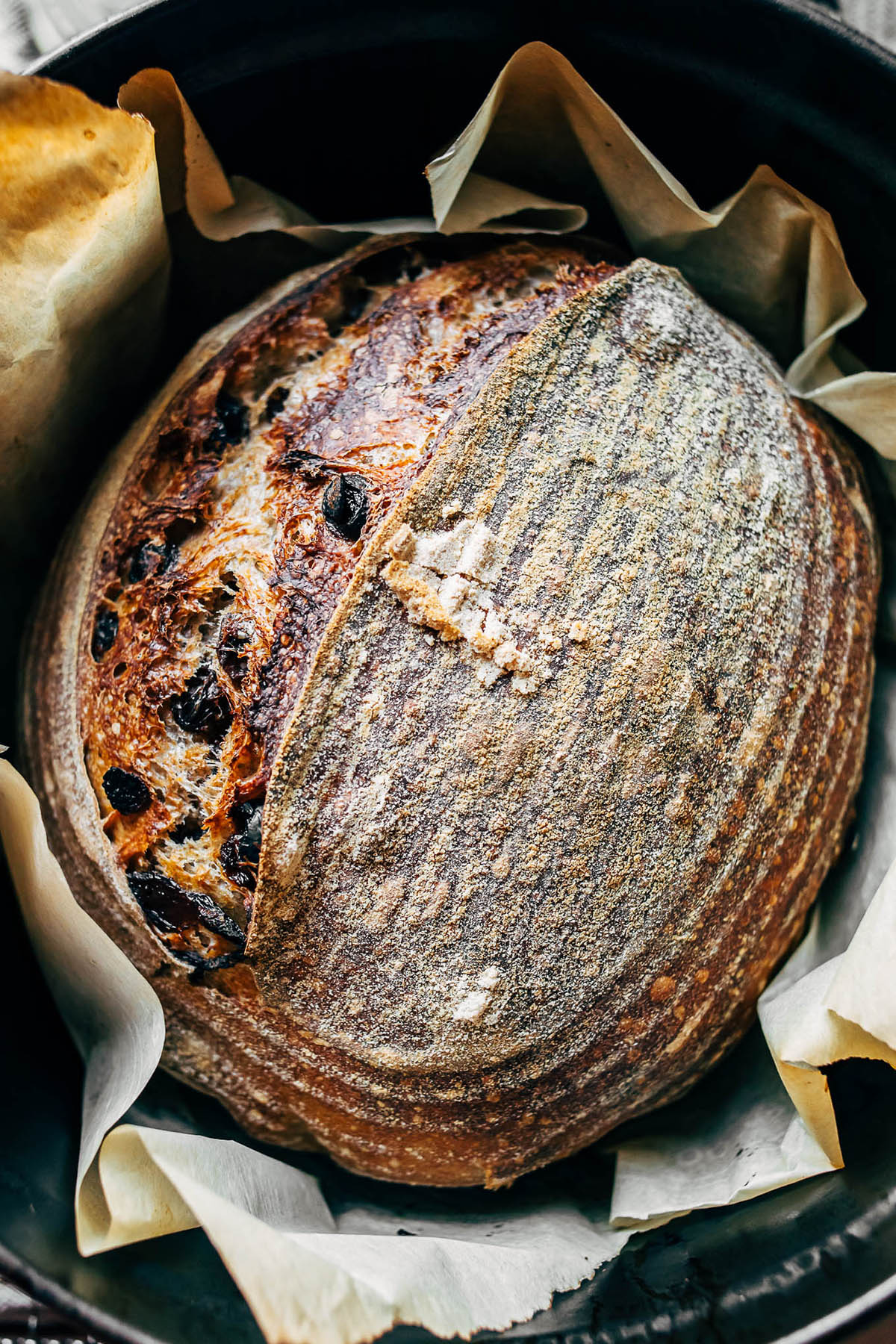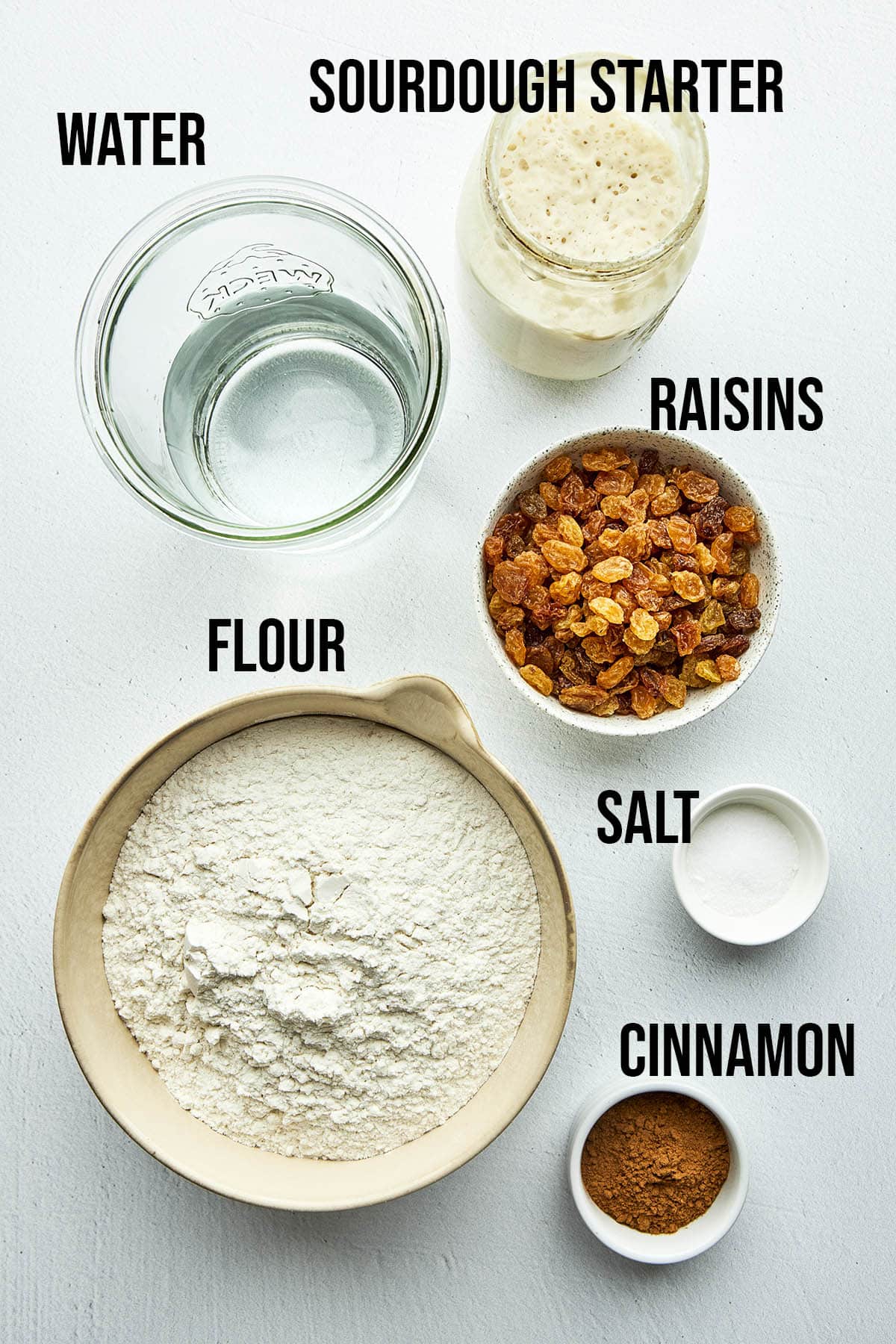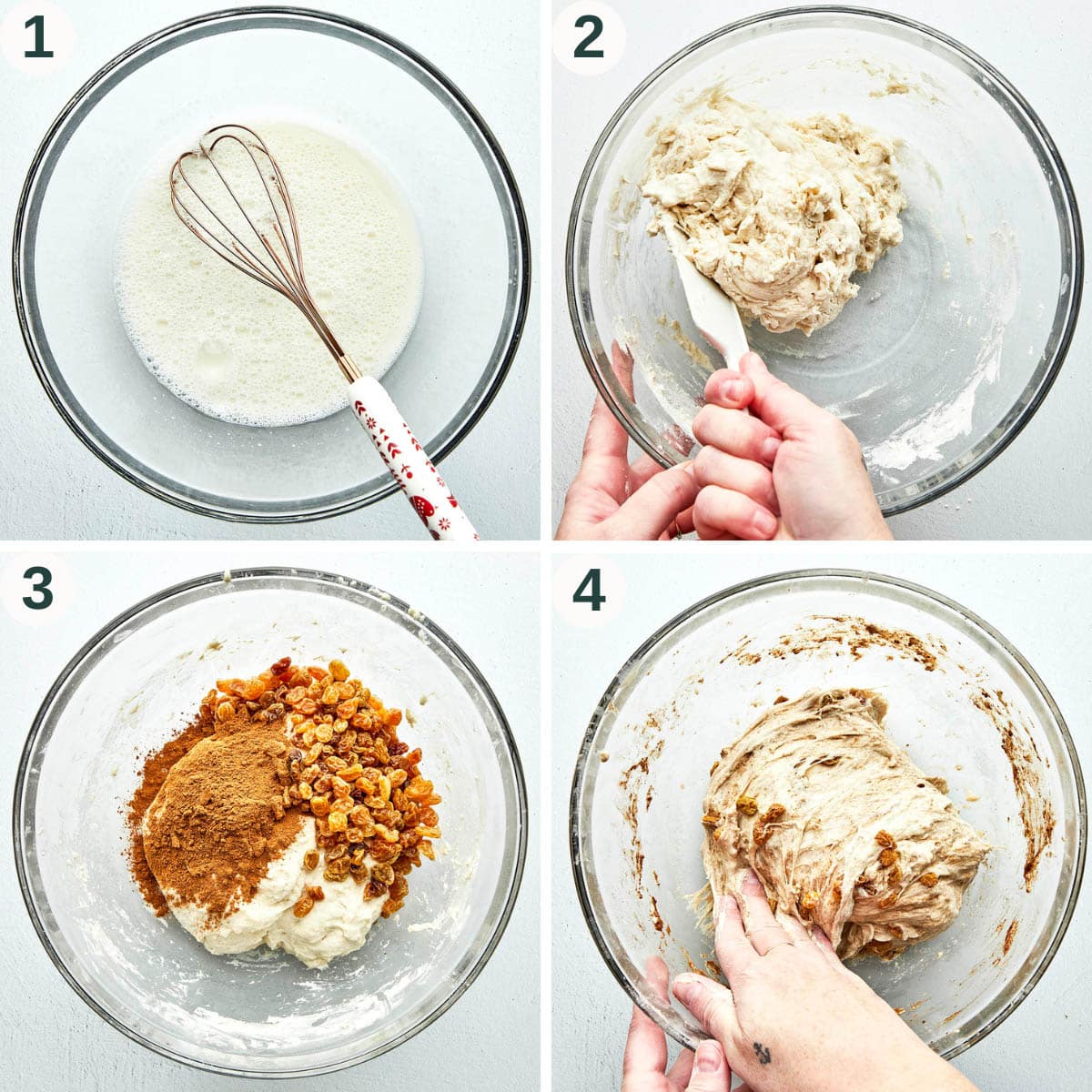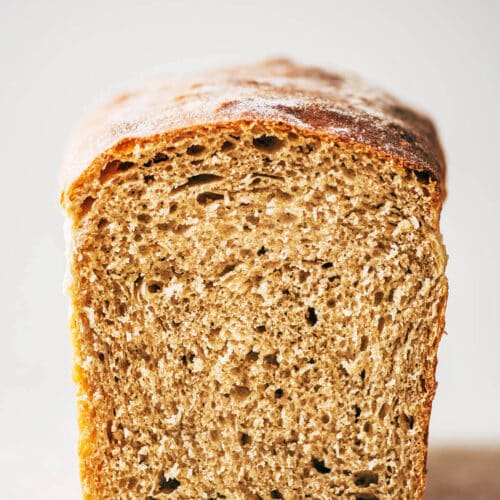Aromatic cinnamon and sweet raisins take your everyday sourdough bread to new heights! Cinnamon raisin sourdough bread is an easy win for breakfast or brunch and is totally divine slathered with a knob of butter, a dollop of jam, or toasted straight up. This is a slightly more advanced recipe but a great half whole wheat sourdough if you're looking for a more wholesome loaf with lots of flavour. Cinnamon, raisins, and whole wheat flour make for an outstanding breakfast bread!
For this recipe, you'll need to give yourself about 34 hours make the final loaf. This includes creating the leaven, bulk fermenting, shaping, and baking times. Overall, there are only 4 hours of active time (mostly waiting to do the stretches). The remainder is simply being patient. Below we share a bunch of helpful tips and substitutions you can try with this recipe; this is a pretty versatile loaf, and one you'll want to make again and again.
This recipe is adapted from Wholehearted Eats basic sourdough bread recipe. For some more flavoured sourdough recipes, try our cranberry walnut sourdough bread, rosemary sourdough with black pepper, or anise apricot sourdough.

Jump to:
Ingredients

Ingredient Notes and Substitutions
- Flour: this recipe uses a 60% white and 40% whole grain flour mixture. However, you can use all white or a blend of white and whole wheat flour. Rye flour can add a nice depth of flavour, but we recommend using only about 10% rye due to it's lower gluten content.
- Levain: you can use either levain or active sourdough starter, whatever is easiest for you. If you have a starter that's ready to use, you can skip the overnight levain instructions.
- Dried fruit and spices: while this recipe puts cinnamon and raisins on a pedestal, there are countless other dry fruits and spices you can use. Dried figs, cherries, cranberries, or dates are excellent choices. Try adding nutmeg or a dash of cloves for added warmth.
- Chopped nuts: nuts and seeds are great additions to bread. They add protein, fibre and flavour. Use unsalted nuts and note that walnuts may turn your bread crumb a tiny bit pink!
How to Make Cinnamon Raisin Sourdough

Step 1: if using levain, prepare it the night before. Mix the levain or starter with the water.
Step 2: add the flour and mix to combine. Set aside to autolyse and soak the raisins in the meantime.
Step 3: mix the salt into the dough, then add the raisins and cinnamon.
Step 4: do six rounds of stretches and folds, once every 30 minutes.

Step 5: shape the dough into a boule and place it into a prepared banneton. Refrigerate the dough overnight.
Step 6: the next day, preheat the oven and dutch oven. Turn the dough out onto parchment paper and score.
Step 7: bake the bread in the preheated dutch oven for 20 minutes with the lid on and about 15 with the lid off.
Step 8: cool the bread fully on a wire rack before slicing.
Top Tips
- Don't worry about a longer ferment: cinnamon slows the fermentation of sourdough. As such, we recommend extending the dough's bulk fermentation time by roughly 30-60 minutes, if necessary. Bottom line, don't stress if your dough takes slightly longer to bulk ferment.
- Use a scale: we don't provide cup measurements for sourdough because it needs to be exact. Grams are the first measurement but ounces are provided in the recipe card too. An electric scale is best. If you switch to weighing ingredients you'll immediately see much more consistent results in your baking!
- No banneton, no problem: if you don't want to buy extra tools, you can use a bowl instead. See our guide on sourdough tools for more information.
How to Store
Storage: we recommend storing your sourdough in a paper bag or wrapped with beeswax wrap. It will keep for several days at room temperature this way – see Sophie's guide on how to store sourdough bread.
Freezing: the fully cooled loaf can be frozen, wrapped well (aluminum foil is great) for up to three months. We suggest freezing individual slices for easy servings, and they can be thawed right in the toaster.
Baker's Schedule
Two Nights Before Baking
Make the Levain: Take out about 1-2 tablespoon of your starter from the fridge and mix it with 50g of room temperature water and 50g of flour. Cover the bowl with a plate and leave it on the counter to ferment overnight for approximately 8-12 hours.
One Day Before Baking
Autolyse (40 minutes): Whisk the levain into the water in a large mixing bowl. Add all of the flour to this mixture and use your hands to mix into a rough, shaggy dough.
While the dough is resting, soak your raisins (more on that below).
Mix: After the autolyse, add the salt and mix until it's combined with the dough. Drain the raisins and add them to the dough with the cinnamon.
Fold (3 hours): Stretch and fold the dough every 30 minutes over the next 3 hours, for a total of 6 stretches and folds. This creates structure in the bread and is one of the most important elements of the process.
Shaping (30 minutes): Take your dough out of the bowl and place it onto a floured surface to rest for 20 minutes. Shape the loaf and place in a floured bowl or banneton (top-down, seam side up). Cover with a tea towel and refrigerate overnight.
Day of Baking
Morning Bake (1 hour 20 minutes): Preheat your Dutch oven in the oven for at least 30 minutes. Invert the shaped, refrigerated dough onto a piece of parchment paper (large enough to lift the paper with your hands) and score in any pattern you like.
Place the scored loaf into the preheated Dutch oven and reduce the heat. Bake, covered, for about 20 minutes before uncovering and baking another 20-25 minutes.
Cool the bread fully before slicing.

Soak Those Raisins!
It's really important to make sure bread dough is adequately hydrated. Because dried fruit contains little to no moisture, it will easily suck up the water from your dough. Dough that lacks moisture will be stiff, hard to work with, and won't rise properly.
To prevent those thirsty raisins from drying up your bread, hydrate them with room temperature water before adding them to the dough. This applies to any dried fruit substitutions you might use in this recipe.
If you're feeling adventurous, try soaking the raisins with a little vanilla extract or a pinch of vanilla bean seeds for added depth of flavour.
FAQ
What happens if you add sugar to sourdough?
Sugar works the same way for sourdough as it does for yeast-based breads. It makes the bread rise faster. We don't recommend adding sugar to sourdough recipes that don't call for it, but you do add it to enriched sourdough recipes like cinnamon rolls.
Why add salt later in sourdough?
It's down to personal preference to add salt after the autolyse but we do find that it makes the dough easier to work with. An autolyse hydrates the flour(s) and makes them less sticky, and salt can interfere with that in our experience.
What happens if I autolyse too long?
If you forget about the dough during the autolyse period, it can result in a sticky, dense loaf. Try to set aside the time needed and use timers to make sure you're doing each step at the right moment.
More Sourdough Bread Recipes
If you make this Cinnamon Raisin Sourdough Bread recipe or any other sourdough recipes on the Baked Collective, please take a moment to rate the recipe and leave a comment below. It’s such a help to others who want to try the recipe. For more baking, follow along on Instagram, TikTok, and YouTube.
Cinnamon Raisin Sourdough Bread
Equipment
- Digital kitchen scale
- Mixing bowl
- Banneton
- Tea towel
- Dutch oven
- Parchment paper
- sharp knife
- Wire rack
Ingredients
- 100 grams levain or active starter
- 375 grams water room temperature
- 500 grams flour*
- 10 grams sea salt
- 125 grams raisins
- 8 grams ground cinnamon
Instructions
TWO NIGHTS BEFORE
Make the levain:
- Take out about 1-2 tablespoons of your starter from the fridge and mix it with 50 grams of room temperature water and 50 grams of flour (sifted bread flour, whole grain, spelt, or a combo - whatever you prefer as long as the flour to water ratio is 1:1).
- Cover the bowl with a plate and leave it on the counter to ferment overnight for approximately 8-12 hours.
ONE DAY BEFORE
- Once your levain is ready, combine 100 grams of the levain with 375 grams of water. Add the flour to the water mixture and, using your hands, mix to combine.375 grams water, 100 grams levain, 500 grams flour*
- Once the dough is mixed, cover with a tea towel and let sit at room temperature for 40 minutes to rest. Meanwhile, soak the raisins in room temperature water (make sure the raisins are covered with at least an inch of water).125 grams raisins
- After the elapsed 40 minute resting time, add the salt. Mix well until combined. Drain the raisins and mix them into the dough along with the cinnamon.10 grams sea salt, 8 grams ground cinnamon, 125 grams raisins
Do the first fold:
- To do this get your hands damp and reach under the dough on the opposite side of the bowl from you.
- Pull the dough up and over towards you.
- Repeat this so the side closest to you folds over to the side away from you and the side on your left folds towards you right, and your right folds towards your left. Think of it as wrapping a package.
- Then, scoop your hands under the ball of dough and flip it over completely. This completes one “fold”.
- Complete 6 more folds (one fold every 30 minutes) for 3 hours total.
Shaping the dough:
- Begin by taking the dough out of the bowl and letting it rest on the counter for 20 minutes.
- Meanwhile, prepare your banneton by dusting it with flour, or layer a clean tea towel in a medium mixing bowl and dust liberally with flour (50-50 wheat flour and rice flour is a great dusting combo).
- Shape your dough making sure you get as much surface tension as possible without tearing the outside of the loaf.
- Once shaped, turn the loaf into the lined and floured bowl or banneton (top-down, seam side up).
- Gently flour the top (previously the bottom) of the dough before covering with the edges of the tea towel. Set in the fridge overnight.
BAKE DAY
- The next day place your dutch oven in the oven and preheat to 500°F (260°C) or as hot as your oven can go, but no higher than 500°F (260°C).
- After the oven has come to temperature, let the dutch oven continue to preheat for another 30 minutes.
- Once the dutch oven has been preheated, take your bread out of the fridge.
- Gently invert the dough onto a piece of parchment paper that will be large enough to lift your bread into and out of the dutch oven.
- Gently score the bread with a sharp knife or bread lame.
- Using oven mitts, carefully remove the dutch oven from the oven, take off the lid and then carefully lift the dough into the pot using the parchment paper.
- Using oven mitts, carefully place the lid back on the dutch oven and put the entire dutch oven back into the heated oven.
- Reduce the heat to 230°C (450°F) and bake for 20 minutes. Carefully remove the lid (be careful of steam) and bake for another 20-25 minutes with the lid off.
- Remove the pot from the oven and carefully lift out the loaf using the edges of the parchment paper and let cool completely on a wire rack.
- If heat makes it too difficult to extract the dough and parchment layer safely, just let the loaf cool in the Dutch oven - don't risk burning yourself.





Is the bulk ferment happening during the 3hrs of stretch and folds? Should I be waiting to see an increase in the dough if it hasn’t before the stretch and folds are done?
Most of the bulk fermentation is cold, so some fermentation will occur at room temperature before refrigerating it overnight. You'll see some growth in the loaf the next day, so don't worry if it isn't proofing on the counter.
Good day,
Just a note to say that some of your recipe links are showing up as a “critical error” ( also the about, and work with us links)
Especially the sourdough bagel recipe which I love and use often.
Thanks
Hi Cecelia, this is a different site from baked-theblog, which is no longer being updated by the person who owns those recipes (we transferred ours over to this site). The bagel recipe is one of them and we are working on a new recipe to share here, which will hopefully be available next week.
Can I use 60% white flour and 40% whol grain rye flour?
Hi Monica, we recommend using a maximum of 20% whole grain rye flour. Any more and the dough will be sticky and hard to work with.
Love the Cinnamon Sourdough Bread recipe, it is fantastic! Came out perfect! 💫
Makes it easy to trust that the recipes are correct, will be trying more going foreward. I am a beginner with sourdough. Thanks ladies, much appreciated. 🌹
This is the recipe my husband is most happiest I found in my sourdough journey , he cannot resist this bread. It tops my discard white choc banana bread which is a big ask. He literally raves about it and acts like a kid in a candy store once he knows I'm baking it . It's delicious . Endebted to you for sharing this recipe xo. Gday from Australia
What is the purpose of soaking the raisins? Also, many other recipes don’t add in the raisins and cinnamon until the shaping so that it makes a swirl. I’m eager to see how this turns out tomorrow!
Hi Morgan, there's a section in the post about why it's necessary to soak the raisins. It's really important to make sure bread dough is adequately hydrated. Because dried fruit contains little to no moisture, it will easily suck up the water from your dough. Dough that lacks moisture will be stiff, hard to work with, and won't rise properly. This isn't a cinnamon swirl loaf sweet bread, so it's not swirled in.
Excellent texture, perfect flavor and great instructions . Will make again
I've just taken this out of my oven and enjoying a slice with my espresso. It's a bit dense and I think its possibly due to several factors : using organic wholewheat White flour (all I have) and that the starter was young (6 days old but energetic) and not proving long enough or cooking long enough! Whew. Lots to work on. Got great oven spring however and it takes delish!
Should the dough rise at room temperature/double in size before shaping it and putting it in the fridge?
Hi Amber, no, this recipe doesn't require an additional rising period (unfortunately we recently switched to a new site, and lost hundreds of comments on this recipe!). Consider the long stretching and folding time to be like a bulk ferment.